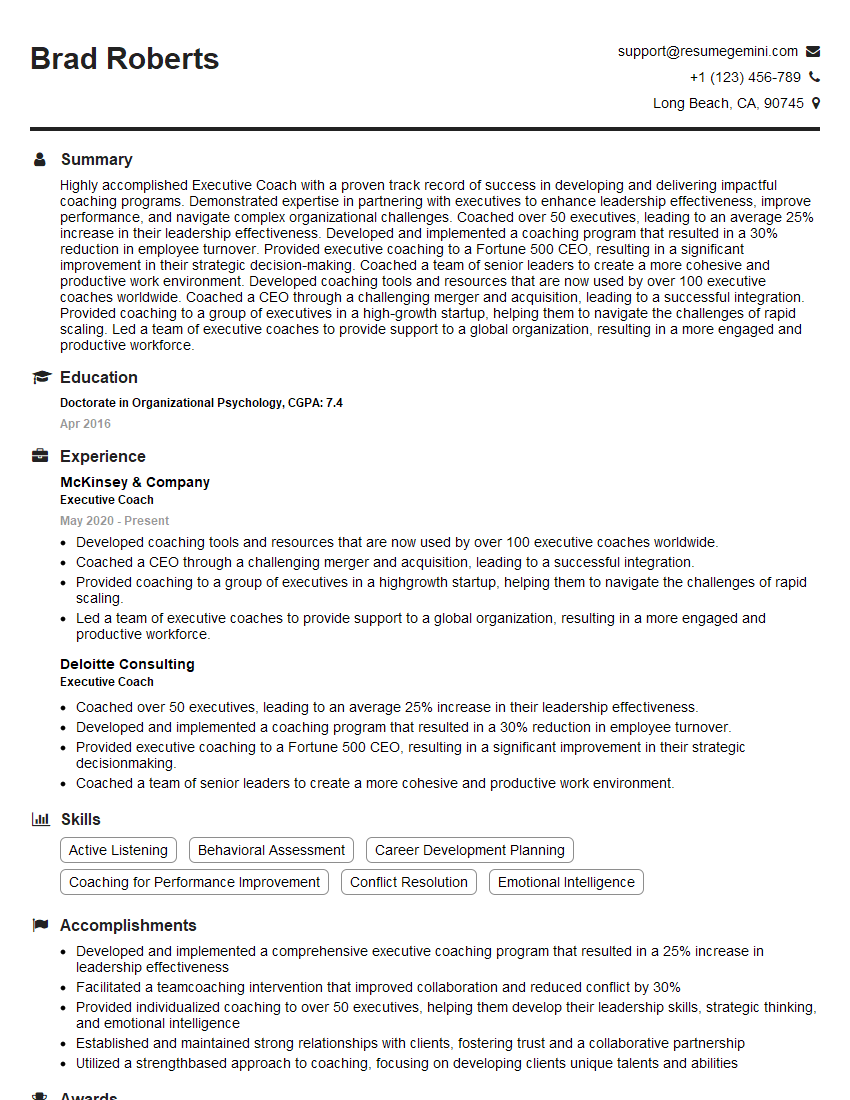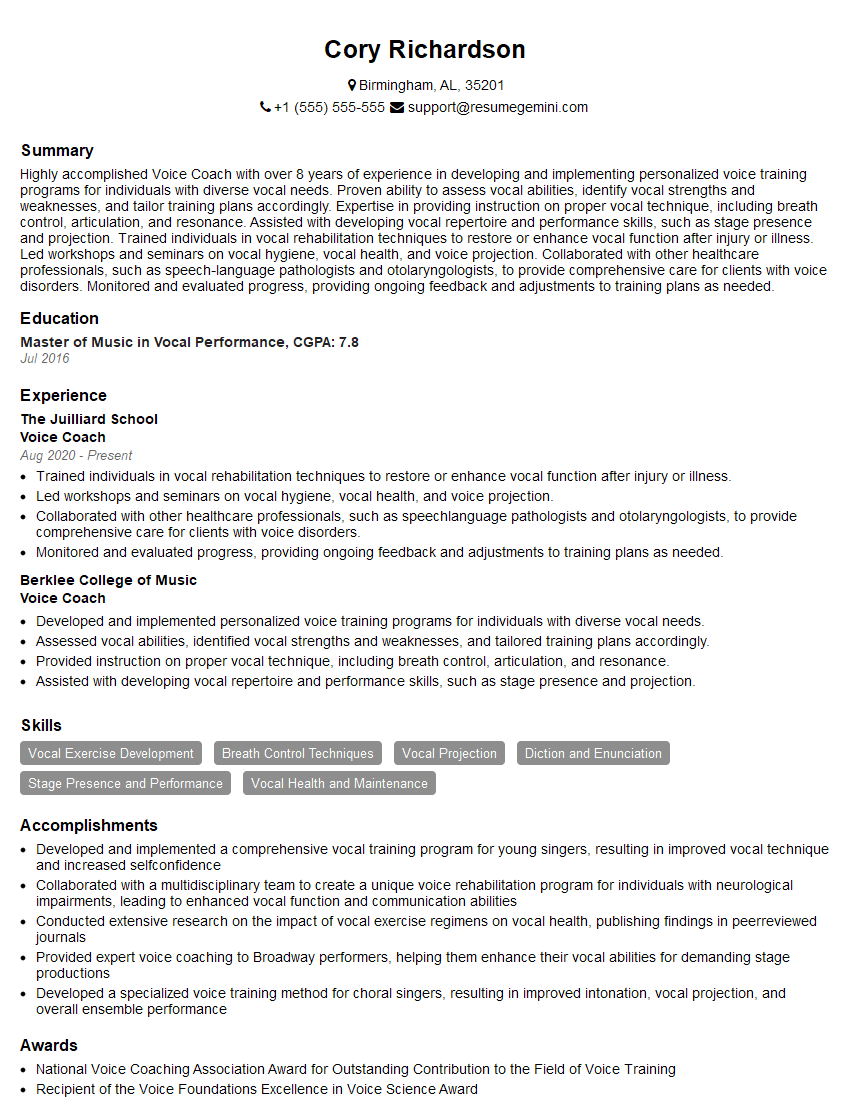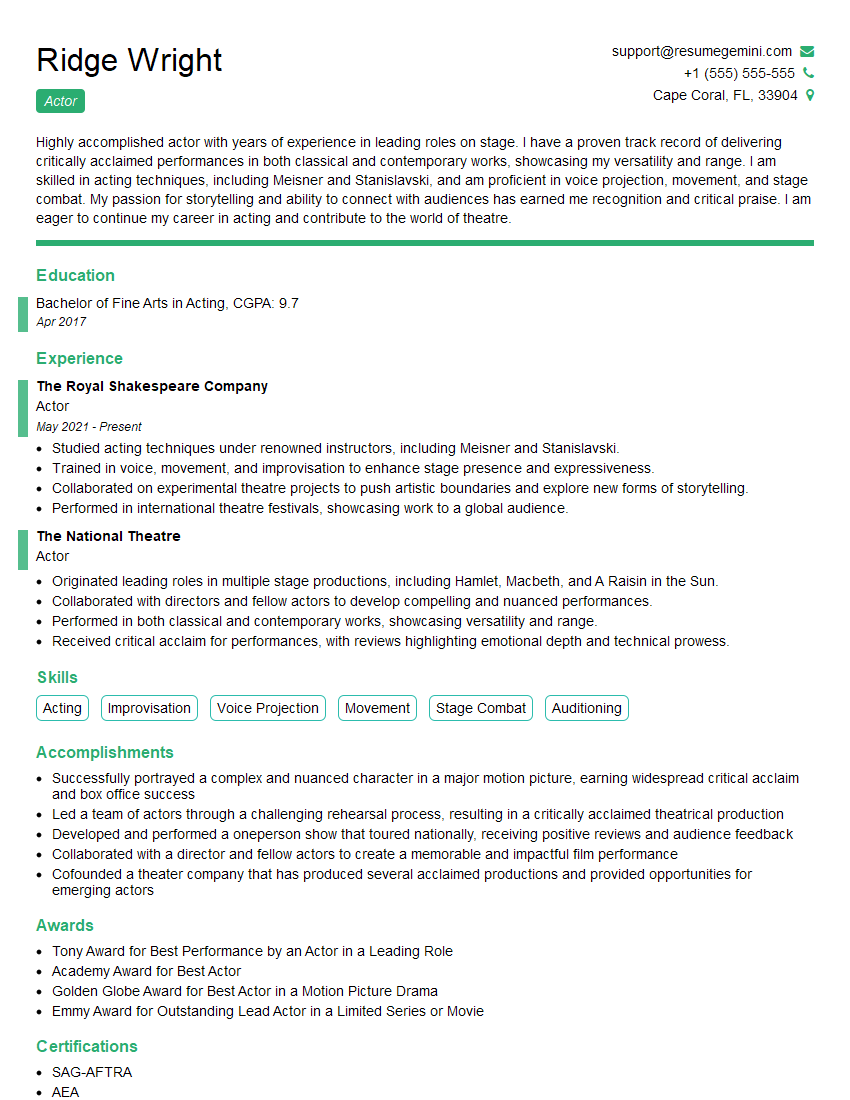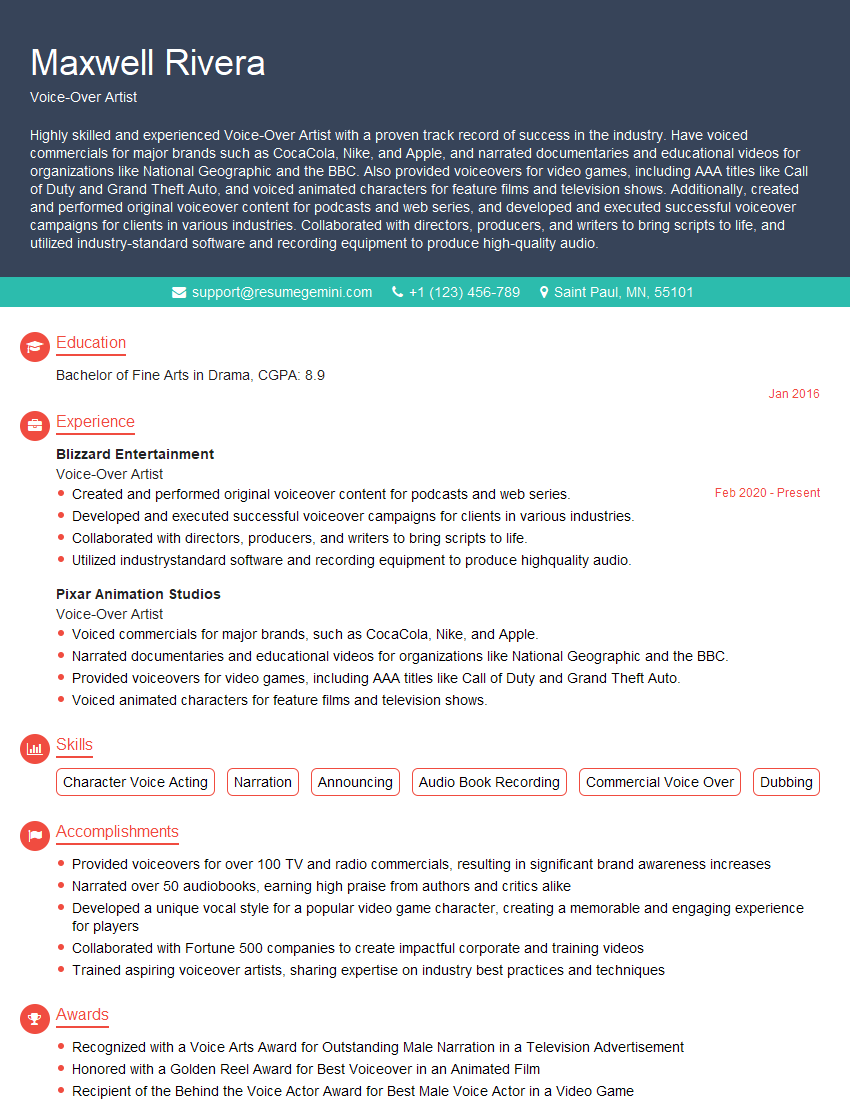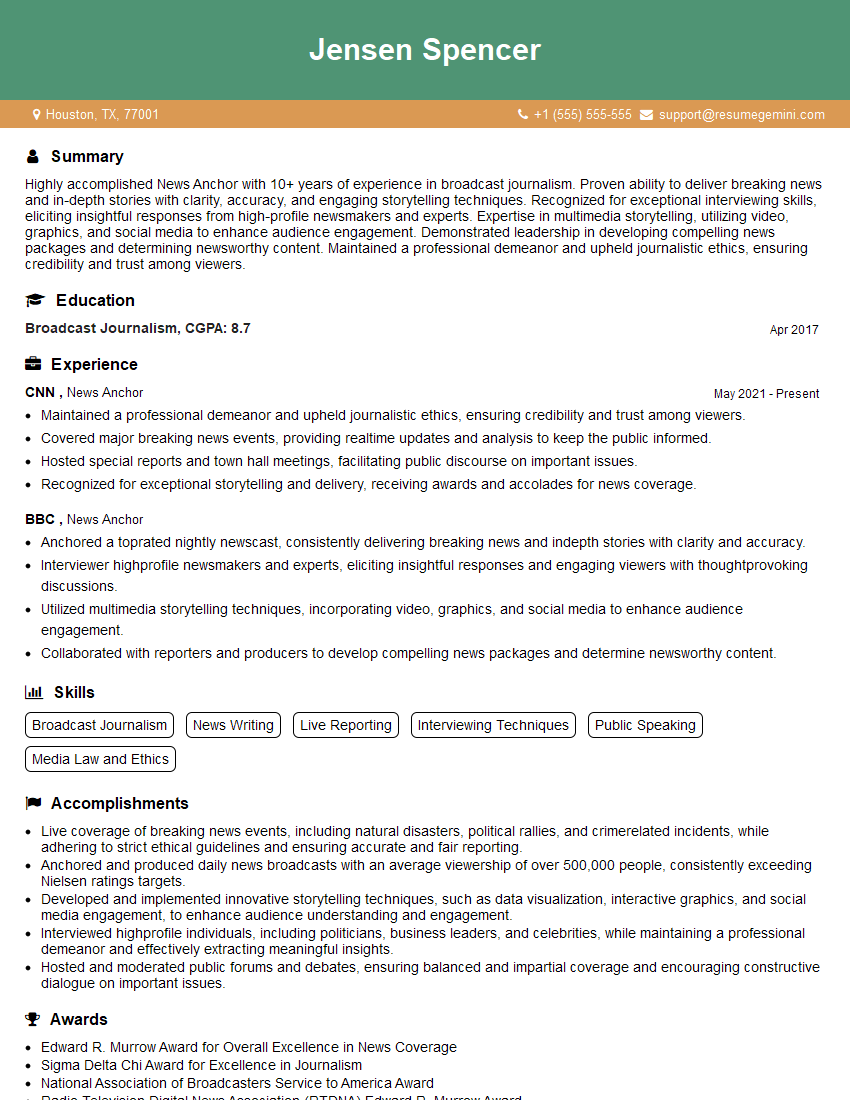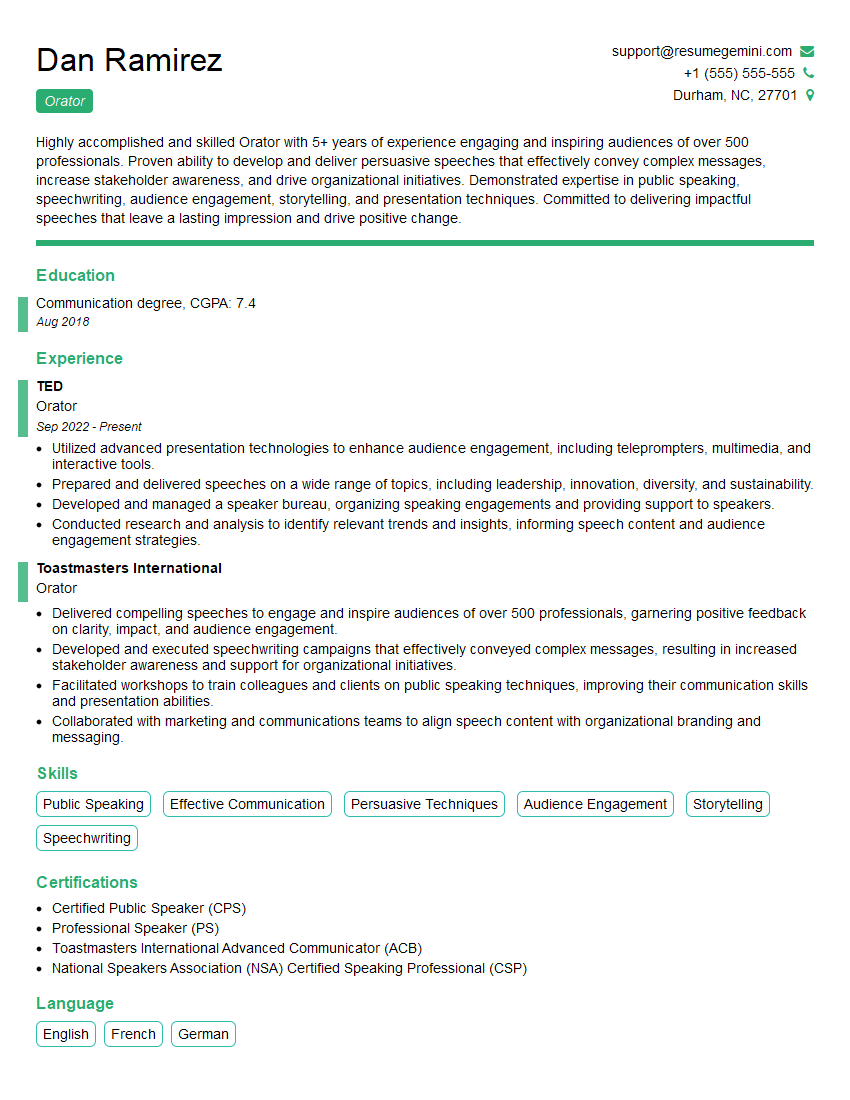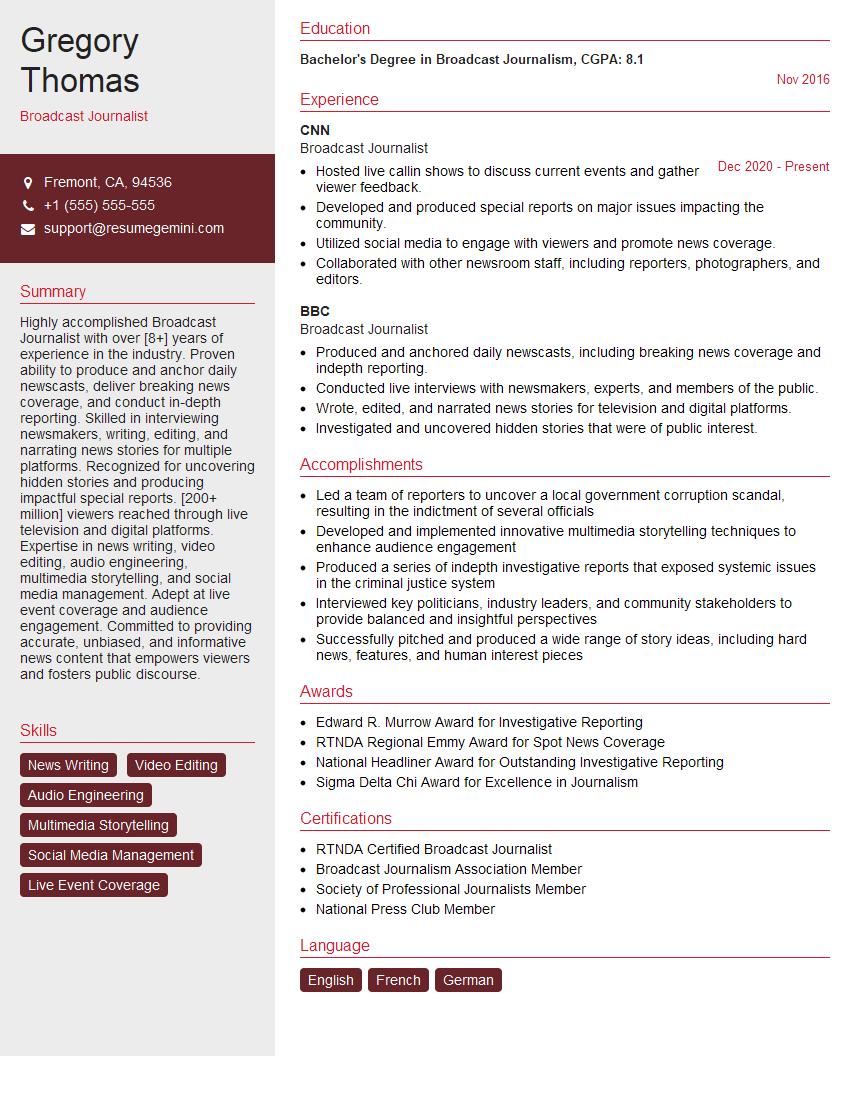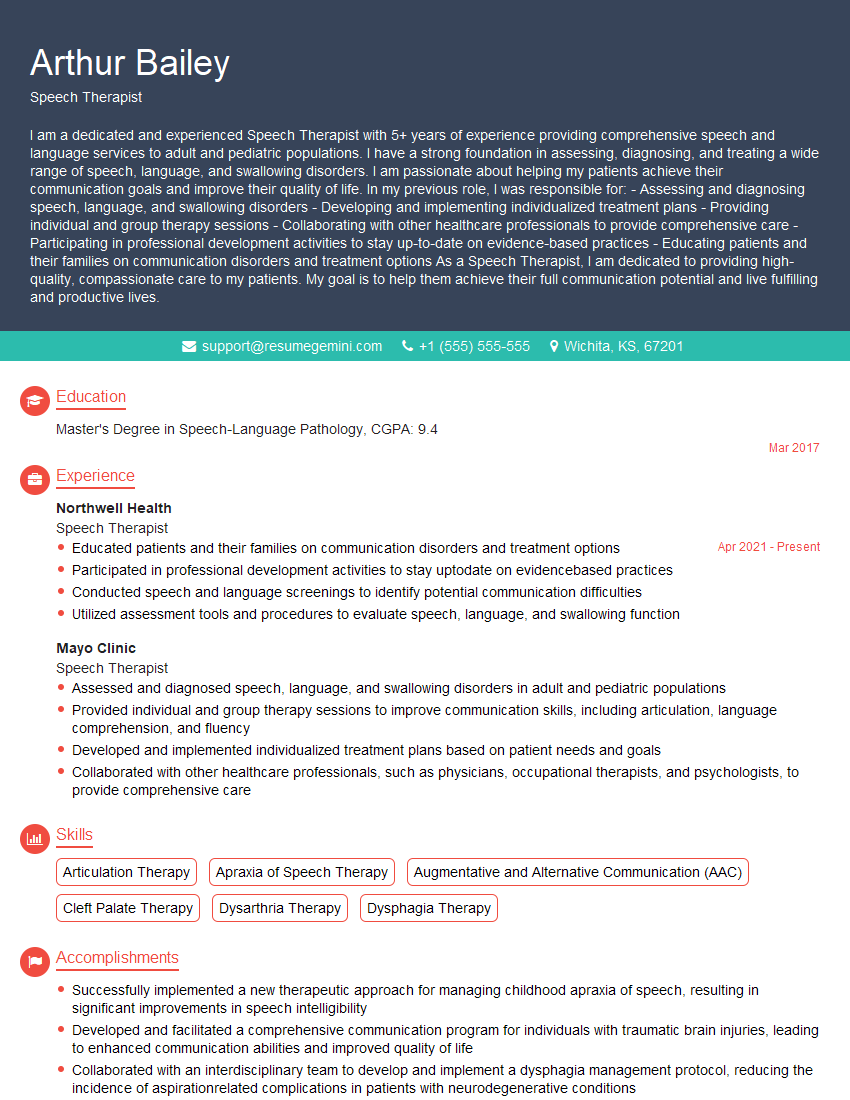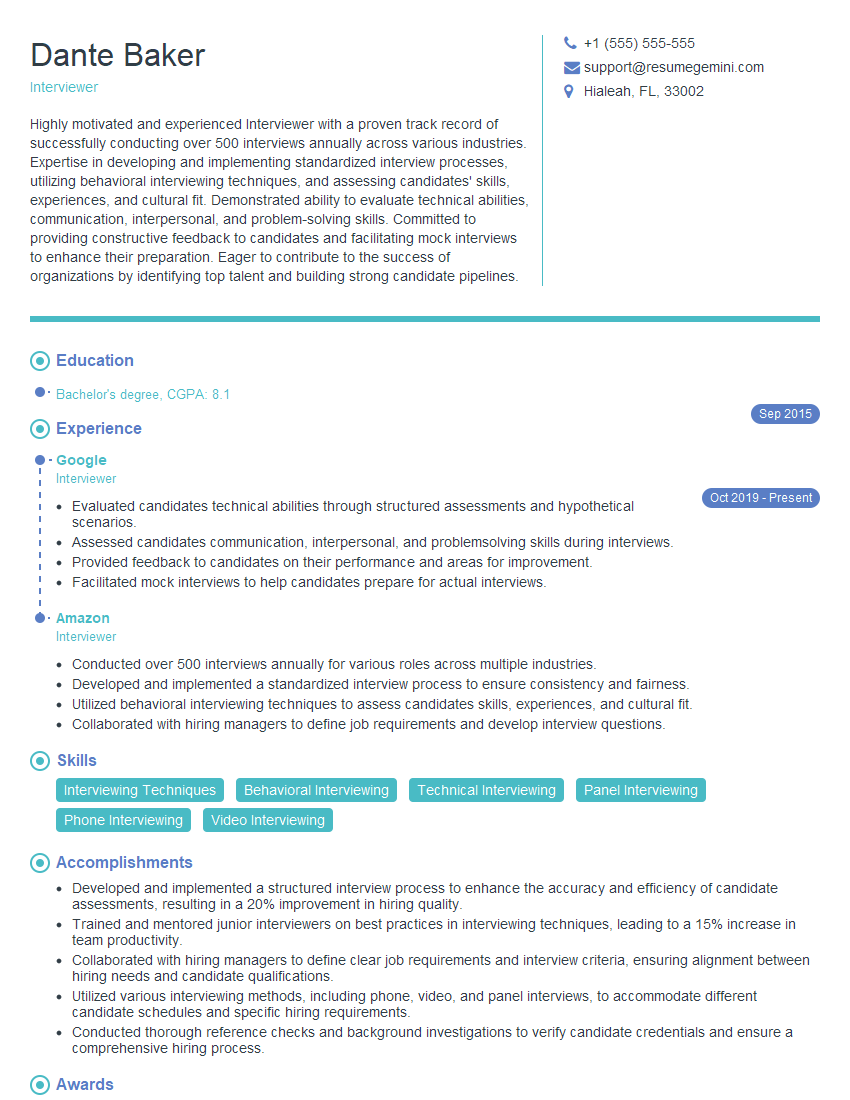Cracking a skill-specific interview, like one for Speech Delivery, requires understanding the nuances of the role. In this blog, we present the questions you’re most likely to encounter, along with insights into how to answer them effectively. Let’s ensure you’re ready to make a strong impression.
Questions Asked in Speech Delivery Interview
Q 1. Describe your experience crafting compelling narratives for presentations.
Crafting compelling narratives for presentations involves more than just stringing facts together; it’s about weaving a story that resonates with the audience on an emotional level. I begin by identifying the core message and then construct a narrative arc – a beginning, middle, and end – that builds suspense, reveals insights, and ultimately leaves a lasting impression. This often involves using storytelling techniques like anecdotes, metaphors, and case studies to illustrate key points and make the information relatable. For example, instead of simply stating statistics about climate change, I might share a personal story about witnessing the effects of deforestation firsthand, followed by the data to support my emotional appeal. This approach helps the audience connect with the information on a personal level, making it more memorable and persuasive.
Another crucial element is understanding the audience’s existing knowledge and expectations. Tailoring the narrative to their specific needs and interests ensures that the story resonates and feels relevant. I always consider the context of the presentation: Is it a formal academic setting or a more informal business meeting? This understanding directly informs the tone and style of the narrative.
Q 2. How do you adapt your speech delivery style to different audiences?
Adapting my speech delivery style to different audiences is paramount for effective communication. I approach this by first analyzing the audience’s demographics, background knowledge, and expectations. For instance, a presentation to a group of seasoned professionals will differ significantly from one delivered to university students. Professionals might appreciate a more concise and data-driven approach, while students might benefit from more interactive elements and engaging storytelling.
My adaptations go beyond just the content. I adjust my language, tone, and pace. With a highly technical audience, I can use more specialized jargon, while with a less technical audience, I simplify my language and avoid overly complex terminology. My delivery style also changes; a formal audience might require a more reserved demeanor, while a younger audience might respond better to a more energetic and conversational style. I often incorporate audience interaction – polls, Q&A sessions, and even small group discussions – to tailor the presentation to their specific interests and ensure they remain actively engaged.
Q 3. Explain your method for overcoming stage fright or nervousness.
Overcoming stage fright is a crucial skill for any presenter. My method is multifaceted and focuses on preparation, practice, and mental techniques. Thorough preparation is key – knowing my material inside and out significantly reduces anxiety. I practice my presentation multiple times, ideally in front of a small, trusted audience, to receive feedback and build confidence. This allows me to identify and refine any weak points in my delivery.
Mentally, I employ techniques like deep breathing exercises to calm my nerves before a presentation. Visualization, where I mentally rehearse a successful presentation, helps to build positive expectations and reduce negative self-talk. I also remind myself that nervousness is normal and even helpful – it shows I care about the presentation. Finally, I focus on connecting with the audience, viewing them as individuals rather than a monolithic mass, which helps to shift my attention away from my own anxieties.
Q 4. What techniques do you use to maintain audience engagement during a presentation?
Maintaining audience engagement requires a dynamic and interactive approach. I use a variety of techniques, including incorporating storytelling, humor (when appropriate), and rhetorical questions to keep the audience actively involved. Varying my vocal tone, pace, and body language helps to maintain interest and prevent monotony. I also use visual aids effectively (discussed in the next answer), and encourage audience participation through polls, quizzes, or Q&A sessions, creating a more conversational and less lecture-like atmosphere.
A crucial technique is to regularly check in with the audience. I pay attention to their nonverbal cues – are they looking engaged, or are they looking distracted? This allows me to adjust my approach as needed, perhaps by speeding up a slow section or adding an interactive element to a less engaging one. I also structure my presentation with clear signposts, letting the audience know what to expect and where we are in the overall narrative, helping them follow along more easily.
Q 5. How do you incorporate visual aids effectively into your speeches?
Visual aids are powerful tools for enhancing a presentation, but they need to be used strategically. I ensure that visual aids are relevant to the content and serve to reinforce key messages, not distract from them. Overly complex or cluttered visuals can be detrimental, so I prioritize clarity and simplicity. I choose visuals that are visually appealing and easy to understand – charts, graphs, images, and short videos are usually more effective than lengthy blocks of text.
Before incorporating visual aids, I consider the context and the audience. A highly technical audience might appreciate detailed diagrams, while a less technical audience might benefit from simpler infographics. I also ensure that all visual aids are high-quality, professionally designed, and consistent in style. The use of high-contrast colours and easy-to-read fonts is paramount for accessibility and clarity. Finally, I never let the visual aids overshadow the core message; they should complement and enhance the spoken word, not replace it.
Q 6. Describe a time you had to deliver bad news effectively. What was your approach?
Delivering bad news requires sensitivity, empathy, and a clear, concise approach. In one instance, I had to inform a team that their project, despite significant effort, wasn’t meeting the necessary criteria for funding. My approach was to prioritize honesty and transparency while mitigating the emotional impact of the news.
I started by acknowledging the team’s hard work and dedication, showing genuine appreciation for their efforts. I then clearly and directly explained the reasons why the project didn’t meet the funding criteria, using factual data and avoiding emotional language. I followed this with a plan for moving forward, suggesting alternative strategies or avenues for pursuing the project’s goals. I made sure to create a space for open discussion, allowing the team to express their concerns and ask questions. Providing this space for dialogue demonstrated empathy and respect, helping them navigate their disappointment and frustration more effectively.
Q 7. How do you manage Q&A sessions after a presentation?
Managing Q&A sessions effectively involves preparation, active listening, and thoughtful responses. Before the session, I anticipate potential questions based on the presentation’s content and the audience’s likely concerns. This helps me formulate concise and informative answers. During the Q&A, I actively listen to each question, ensuring I fully understand the query before responding. I maintain eye contact with the questioner, showing respect and attentiveness. I respond clearly and concisely, avoiding jargon and technical terms whenever possible. If I don’t know the answer, I admit it honestly and offer to find the information and follow up.
I also manage the flow of the Q&A session effectively. I prioritize questions that are most relevant to the presentation’s core message and ensure that everyone gets a chance to participate. I politely but firmly manage any disruptive or irrelevant questions, guiding the conversation back to the key topics. Time management is crucial; I end the Q&A session within the allotted time, ensuring a smooth transition to the next stage of the event. I strive to create a positive and respectful environment where participants feel comfortable asking questions and engaging in thoughtful dialogue.
Q 8. What is your process for preparing and rehearsing a speech?
My speech preparation process is a multi-stage approach focusing on audience understanding, content mastery, and delivery refinement. It begins with a deep dive into my audience: who are they, what are their interests, and what do they already know about the topic? Understanding this shapes my message and tone. Next, I meticulously research and outline my content, ensuring a logical flow and compelling narrative. This involves creating a detailed script, which acts as a roadmap, but I avoid memorizing it word-for-word. Instead, I focus on mastering the key points and allowing for natural conversational delivery. Rehearsal is crucial; I practice multiple times, refining my pacing, emphasis, and body language. I often record myself to identify areas for improvement. Finally, I conduct a mock presentation with a trusted colleague for feedback. This allows me to test my delivery and address any potential weaknesses before the actual speech.
- Audience Analysis: Understanding the audience is paramount – a technical presentation to engineers will differ greatly from a motivational speech to students.
- Content Structuring: A clear structure with a strong introduction, compelling body, and memorable conclusion is essential. Using storytelling techniques enhances engagement.
- Rehearsal and Feedback: Repeated practice builds confidence and allows for refinement. Feedback from trusted sources is invaluable.
Q 9. Explain your understanding of vocal projection and articulation.
Vocal projection and articulation are fundamental aspects of effective speech delivery. Vocal projection refers to the ability to make your voice heard clearly and powerfully across a room, or even a large auditorium. It’s not about shouting, but about using proper breath support and resonating your voice effectively. Articulation, on the other hand, focuses on the clarity and precision of your spoken words. It involves enunciating each sound clearly, avoiding mumbling or slurring. Think of a singer; their vocal projection ensures their voice fills the concert hall, while their articulation makes every note crisp and understandable.
To improve projection, I focus on diaphragmatic breathing, proper posture, and vocal exercises. For improved articulation, I practice tongue twisters and pay close attention to the formation of individual sounds. Poor articulation can lead to misinterpretations, while poor projection leaves the audience straining to hear.
Q 10. How do you use body language to enhance your communication?
Body language plays a crucial role in enhancing communication. It’s often said that communication is 55% body language, 38% tone of voice, and only 7% words. I use body language consciously to reinforce my message, connect with the audience, and maintain engagement. This includes maintaining good posture, using appropriate hand gestures to emphasize points, making eye contact with different audience members, and moving purposefully on stage. A stiff, unmoving speaker can quickly lose their audience’s attention. Conversely, natural and purposeful movements can significantly boost engagement and understanding.
For example, a slight pause and a deliberate gesture can amplify a key point, while eye contact creates a personal connection with each listener. I avoid distracting mannerisms like fidgeting or excessive pacing.
Q 11. Describe your experience using different presentation software (e.g., PowerPoint, Keynote).
I have extensive experience using PowerPoint and Keynote for presentations. Both are valuable tools, but my choice depends on the specific needs of the presentation and the audience. PowerPoint is more widely compatible, while Keynote offers a more visually appealing and intuitive design environment. My approach focuses on creating visually compelling slides that complement, rather than dominate, my speech. I avoid cluttering slides with too much text, opting instead for concise bullet points, impactful visuals, and data representations that are easy to grasp. I understand the importance of appropriate font sizes, color palettes, and image selection to maintain visual clarity and engagement.
I believe the presentation software should enhance, not overshadow, the message. Overly complex animations or distracting visuals detract from the speaker’s impact.
Q 12. How do you handle interruptions or unexpected questions during a presentation?
Handling interruptions or unexpected questions is a crucial aspect of effective public speaking. My approach involves maintaining composure and addressing the interruption professionally. If it’s a simple clarification, I’ll answer briefly and seamlessly transition back to my presentation. If it’s a more complex question, I’ll acknowledge it, potentially paraphrasing for clarity, and answer thoughtfully, either immediately or after noting it for later if it significantly shifts the presentation’s direction. If the interruption is disruptive or irrelevant, I will politely but firmly guide the conversation back to the main points. The key is to remain calm, respectful, and focused on maintaining the flow and overall objective of the presentation.
For example, if someone asks a question unrelated to the topic, I might say, ‘That’s an interesting point, but let’s address it after the presentation to keep us on track.’ This approach demonstrates respect for the audience while ensuring the presentation remains focused.
Q 13. Explain your approach to incorporating humor or storytelling into a presentation.
Incorporating humor or storytelling into a presentation can significantly enhance audience engagement and memorability. However, it’s crucial to ensure the humor or story is relevant, appropriate, and adds value to the message. I carefully select anecdotes or jokes that resonate with the audience and subtly reinforce the key themes of the presentation. The humor should be tasteful and never at the expense of the audience. A well-placed story can create an emotional connection, making the presentation more relatable and impactful.
For example, I might begin with a relatable anecdote to connect with the audience before transitioning into the main topic. Or, I might use a short, relevant humorous story to illustrate a complex point in a more engaging manner.
Q 14. How do you ensure your message is clear and concise for your audience?
Ensuring a clear and concise message requires careful planning and execution. This starts with identifying the core message I want to convey and prioritizing it throughout the presentation. I avoid jargon or overly technical terms unless the audience is familiar with them. Instead of overwhelming the audience with excessive information, I focus on key takeaways, delivering them clearly and concisely. I use visual aids to reinforce and clarify my points, and I practice my delivery to ensure a natural and engaging flow. Regular pauses and strategic emphasis on key words or phrases further enhance clarity and understanding. A clear, concise message leaves a lasting impact on the audience.
For example, I might use a single, powerful image or graphic to illustrate a key concept, rather than explaining it with multiple paragraphs of text.
Q 15. What strategies do you use to connect with your audience on an emotional level?
Connecting with an audience on an emotional level is crucial for impactful speech delivery. It’s about transcending the intellectual and reaching the heart of your listeners. I achieve this through several strategies:
- Storytelling: Weaving personal anecdotes or relatable stories into my speech creates an immediate connection. For instance, when discussing the importance of perseverance, I might share a personal story about overcoming a challenge, allowing the audience to empathize with my experience and understand the message on a deeper level.
- Vulnerability: Sharing genuine emotions and experiences, even if they are difficult, builds trust and fosters empathy. Showing vulnerability humanizes the speaker and makes the message more relatable.
- Passion and Enthusiasm: My own genuine excitement about the topic is infectious. When I’m passionate about what I’m saying, my energy and enthusiasm naturally translate to the audience, drawing them in emotionally.
- Using evocative language: I carefully choose words that evoke strong emotions and imagery. This helps paint a vivid picture in the audience’s minds and creates a more memorable and impactful experience.
- Addressing audience needs and values: Before a speech, I research my audience to understand their background, values, and concerns. Tailoring my message to resonate with their specific needs and values creates a powerful emotional connection.
Essentially, it’s about being authentic, relatable, and genuinely invested in sharing my message with the audience. It’s not about manipulating emotions, but about connecting on a human level.
Career Expert Tips:
- Ace those interviews! Prepare effectively by reviewing the Top 50 Most Common Interview Questions on ResumeGemini.
- Navigate your job search with confidence! Explore a wide range of Career Tips on ResumeGemini. Learn about common challenges and recommendations to overcome them.
- Craft the perfect resume! Master the Art of Resume Writing with ResumeGemini’s guide. Showcase your unique qualifications and achievements effectively.
- Don’t miss out on holiday savings! Build your dream resume with ResumeGemini’s ATS optimized templates.
Q 16. Describe a time you had to improvise a speech. How did you handle it?
Improv is a vital skill for any speaker. I once had to deliver a keynote address with only 30 minutes’ notice. The original speaker had fallen ill. My initial reaction was a surge of adrenaline, but I quickly shifted into problem-solving mode.
- Identify the core message: I quickly reviewed the event’s program and identified the central theme. In this case, it was the importance of innovation in the tech industry.
- Structure the speech: I created a simple three-point structure: the past achievements, current challenges, and future opportunities in the field. This gave my improvised speech a clear and logical flow.
- Focus on key examples: Instead of delving into intricate details, I focused on providing strong, relatable examples to illustrate each point. I drew upon my own experience and knowledge of the field.
- Engage with the audience: I made the speech interactive, asking questions and incorporating audience participation where possible. This helped keep the energy high and kept the audience engaged despite the impromptu nature of the presentation.
While the speech wasn’t as polished as a meticulously prepared one, it was effective because I focused on clarity, relevance, and audience engagement. The key is to remain calm, think on your feet, and leverage your existing knowledge and experience.
Q 17. How do you tailor your speech to different communication styles and preferences?
Tailoring my speech depends on understanding my audience’s communication styles and preferences. This involves considering factors such as:
- Audience Demographics: Age, profession, cultural background, and level of expertise influence how I present information. A technical audience expects precise details, while a general audience prefers simpler explanations and engaging anecdotes.
- Communication Preferences: Some prefer concise, direct communication; others prefer a more narrative, storytelling approach. I adapt my style accordingly, sometimes incorporating visuals, humor, or interactive elements.
- Setting and Context: The formality of the setting (e.g., a conference versus a team meeting) dictates the tone and style of my speech. A formal setting requires a more polished, structured approach, while a less formal setting allows for more relaxed and conversational delivery.
For example, when presenting to a group of highly technical engineers, I would use precise jargon and delve into detailed technical specifics. Conversely, when addressing a general audience at a community event, I would use simpler language, more visuals, and focus on connecting with their emotions and personal experiences.
Q 18. How do you identify and correct vocal tics or filler words?
Vocal tics and filler words (like ‘um,’ ‘uh,’ ‘like’) are common challenges, but they can be significantly reduced with conscious effort. My approach is multifaceted:
- Self-Awareness: The first step is to become aware of my own tics. I record myself practicing speeches to identify recurring patterns. This allows for objective assessment and identification of specific problem areas.
- Pauses for Reflection: Instead of filling silences with filler words, I consciously pause. These brief pauses create space for thought, allowing for more natural and fluent speech.
- Rehearsal and Practice: Through consistent rehearsal and practice, I train myself to replace filler words with meaningful pauses or to simply eliminate them. Practicing in front of a mirror or recording myself is crucial.
- Mindfulness and Meditation: Practicing mindfulness techniques helps me become more aware of my speech patterns and improve my ability to control them. Meditation can reduce anxiety and nervous habits.
- Seeking Feedback: Regular feedback from trusted colleagues or mentors helps identify areas needing improvement. Constructive criticism is invaluable in this process.
Addressing vocal tics is an ongoing process. It requires consistent effort and self-discipline, but the rewards of more confident and polished speech delivery are well worth the investment.
Q 19. How do you use vocal variety (pitch, pace, volume) to enhance your speech?
Vocal variety is essential for engaging speech delivery. It prevents monotony and keeps the audience attentive. I utilize variations in pitch, pace, and volume to emphasize different points and create emotional impact:
- Pitch: Varying my pitch adds interest and prevents a flat, monotonous tone. A rising pitch can indicate a question or heighten anticipation, while a lower pitch can create a sense of authority or seriousness.
- Pace: I adjust my pace to match the content. Slowing down emphasizes key points or creates a sense of drama. Quickening the pace conveys excitement or urgency.
- Volume: Volume changes add emphasis and dynamism. A softer volume can create intimacy, while a louder volume commands attention and emphasizes key messages. I avoid shouting, however, ensuring that even the quieter sections are clearly audible.
Consider the analogy of music: a song with a constant, unchanging melody would be dull. Similarly, a speech without vocal variety will lack dynamism and engagement. By consciously controlling these elements, I create a more engaging and memorable speaking experience for my audience.
Q 20. Describe your experience delivering presentations to large or small audiences.
I have extensive experience delivering presentations to diverse audiences, ranging from intimate gatherings to large-scale conferences. The approach differs slightly depending on the size:
- Small Audiences: In smaller settings, I can foster a more conversational and interactive environment. I might encourage questions and feedback throughout the presentation, creating a more intimate dialogue.
- Large Audiences: With larger audiences, my focus shifts to ensuring clear projection, effective visual aids, and strong stage presence. Maintaining consistent eye contact with various sections of the audience helps to create a connection with everyone present.
Regardless of the audience size, my core principles remain consistent: strong message, clear structure, and engaging delivery. Adapting my approach to the specific audience and context ensures effective communication in every situation.
Q 21. How do you use pauses effectively in your speech?
Pauses are often underestimated but are powerful tools in speech delivery. They serve several vital functions:
- Emphasis: A strategic pause before or after a significant point draws attention and reinforces its importance.
- Transition: Pauses provide smooth transitions between different sections or ideas in a speech, preventing abrupt shifts that might confuse the audience.
- Emotional Impact: A well-placed pause can heighten emotional impact. A pause before delivering a powerful statement can build anticipation and increase its impact.
- Audience Engagement: Pauses give the audience time to process information, reducing cognitive overload and increasing comprehension. They also allow for audience reflection and response.
- Breathing and composure: Pauses allow the speaker to breathe, collect their thoughts, and maintain composure, resulting in a more confident and controlled delivery.
The length and placement of pauses are critical. Too many or too long pauses can disrupt the flow, while too few can result in a rushed and incoherent presentation. Mastering the use of pauses is a key element of effective and engaging speech delivery.
Q 22. What methods do you employ to gauge audience understanding and engagement?
Gauging audience understanding and engagement is crucial for effective speech delivery. It’s not just about delivering information; it’s about ensuring the message resonates. I employ a multi-faceted approach, combining observational techniques with direct interaction.
Observation: I carefully watch for nonverbal cues like body language. Are people leaning forward, engaged, or are they looking distracted or restless? Do their facial expressions reflect comprehension or confusion? Are they taking notes or actively participating?
Direct Interaction: I incorporate opportunities for audience participation, such as asking questions, conducting polls (either informally through raised hands or formally using technology), or inviting brief comments. This allows me to assess understanding in real-time and adjust my delivery accordingly.
Post-Speech Feedback: I often solicit feedback through surveys, informal conversations, or even social media. This provides valuable insight into the effectiveness of the speech and areas for improvement in future presentations.
Example: During a recent presentation on sustainable business practices, I noticed several audience members looked confused when I introduced a complex financial model. I paused, simplified my explanation, and used a relatable analogy to illustrate the concept, ensuring a better understanding.
Q 23. How do you handle criticism or feedback on your speech delivery?
Criticism and feedback are invaluable for growth. I approach them constructively, viewing them as opportunities for learning and improvement rather than personal attacks. My process involves:
Active Listening: I carefully listen to the feedback, avoiding interrupting or becoming defensive. I try to understand the perspective from which the criticism is offered.
Reflection: I take time to reflect on the feedback, considering its validity and relevance to my delivery. I ask myself: What aspects of my speech could be improved? Did I misinterpret the audience’s needs?
Implementation: I identify actionable steps based on the feedback. This might involve refining my delivery, improving clarity, adapting my speaking style, or altering the content to better resonate with the audience. I document these changes to ensure consistent improvement.
Example: Following a presentation on data visualization, I received feedback that my visuals were too dense and complicated. This led me to simplify my charts and graphs in subsequent presentations, resulting in a more engaging and effective communication.
Q 24. What are your strengths and weaknesses regarding speech delivery?
My strengths lie in my ability to connect with the audience on an emotional level, tailoring my communication style to suit the specific context and audience. I’m adept at incorporating storytelling and humor to make complex information more accessible. I am also comfortable with impromptu speaking and can adapt quickly to unexpected situations.
However, I recognize that perfection is unattainable. One area I’m continually working on is managing my pace. Sometimes, when particularly passionate about a topic, I tend to speak too quickly. To mitigate this, I actively practice slowing down my delivery and incorporating pauses for emphasis and comprehension.
Q 25. How do you incorporate persuasive techniques into your communication?
Persuasive techniques are essential for effective communication. I incorporate several strategies into my speeches:
Ethos (credibility): I establish my expertise by citing relevant research, sharing personal experiences, or highlighting my credentials. This builds trust and makes my arguments more convincing.
Pathos (emotion): I connect with the audience on an emotional level using storytelling, vivid imagery, and relatable examples. This helps to make the message memorable and impactful.
Logos (logic): I structure my arguments logically, using evidence and reasoning to support my claims. This ensures the persuasiveness is grounded in factual information.
Call to Action: I conclude my speeches with a clear call to action, prompting the audience to take a specific step or consider a particular perspective. This provides direction and encourages engagement.
Example: When persuading investors to support a new venture, I would highlight my experience and expertise (ethos), share a compelling story of overcoming obstacles (pathos), and present a detailed financial projection (logos), culminating in a call to action to invest in the project.
Q 26. Describe your experience working with diverse cultural backgrounds.
I have extensive experience working with diverse cultural backgrounds. My approach emphasizes cultural sensitivity and understanding. I recognize that communication styles vary significantly across cultures, and what is considered appropriate or effective in one culture might not be in another.
Research: Before presenting to a diverse audience, I conduct research to understand the cultural nuances and communication preferences of the different groups represented.
Adaptation: I adapt my communication style accordingly, being mindful of language, nonverbal cues, and cultural values. This might involve adjusting my tone, pace, and use of humor.
Inclusivity: I strive to create an inclusive environment where all voices are valued and respected. This involves being mindful of language, avoiding stereotypes, and promoting active listening.
Example: When presenting to an international audience, I ensured that my slides included visuals and minimal text, recognizing that language barriers might be present. I also incorporated visual aids to make the content more universally accessible.
Q 27. Explain your understanding of nonverbal communication and its impact.
Nonverbal communication plays a significant role in speech delivery, often conveying more than words alone. It encompasses body language (posture, gestures, facial expressions), eye contact, tone of voice, and even the use of space. The impact is multifaceted:
Enhancing Credibility: Confident posture, appropriate eye contact, and a clear tone of voice build trust and credibility.
Connecting with the Audience: Warm smiles, open body language, and engaging gestures create a connection and foster a sense of rapport.
Reinforcing the Message: Gestures and facial expressions can reinforce and emphasize key points, making the message more memorable.
Revealing Emotions: Nonverbal cues can reveal unspoken emotions, either aligning with or contradicting the verbal message. Inconsistencies can undermine credibility.
Example: A speaker who maintains consistent eye contact, uses confident gestures, and speaks with a clear and enthusiastic tone conveys assurance and engagement to the audience, leading to better retention and comprehension.
Key Topics to Learn for Speech Delivery Interview
- Vocal Delivery: Mastering tone, pace, pitch, and volume to engage your audience. Practical application: Practice delivering a short presentation, recording yourself, and analyzing your vocal delivery for areas of improvement.
- Body Language & Nonverbal Communication: Utilizing posture, gestures, and eye contact to enhance your message. Practical application: Practice speaking in front of a mirror, focusing on maintaining confident posture and engaging eye contact.
- Audience Engagement: Techniques for connecting with and captivating your listeners. Practical application: Develop strategies to incorporate questions, anecdotes, or interactive elements into your presentations.
- Structure & Organization: Creating a clear and logical flow for your speeches using effective introductions, body paragraphs, and conclusions. Practical application: Outline several different speeches using different organizational patterns to practice flexibility.
- Storytelling & Narrative: Using narratives to make your speeches more memorable and impactful. Practical application: Practice crafting compelling stories relevant to your field and experience.
- Impromptu Speaking: Developing the ability to think on your feet and deliver concise, coherent responses to unexpected questions. Practical application: Practice impromptu speaking exercises, such as responding to random prompts.
- Handling Q&A Sessions: Mastering techniques for confidently and effectively answering audience questions. Practical application: Prepare answers to common questions in your field and practice responding concisely and clearly.
Next Steps
Mastering speech delivery is crucial for career advancement in many fields, opening doors to leadership roles, impactful presentations, and stronger client relationships. A well-crafted resume is your first step toward securing these opportunities. To maximize your chances, build an ATS-friendly resume that highlights your skills and experience in speech delivery. ResumeGemini is a trusted resource to help you create a professional and effective resume. We provide examples of resumes tailored specifically to Speech Delivery professionals to help you get started.
Explore more articles
Users Rating of Our Blogs
Share Your Experience
We value your feedback! Please rate our content and share your thoughts (optional).
What Readers Say About Our Blog
Hello,
We found issues with your domain’s email setup that may be sending your messages to spam or blocking them completely. InboxShield Mini shows you how to fix it in minutes — no tech skills required.
Scan your domain now for details: https://inboxshield-mini.com/
— Adam @ InboxShield Mini
Reply STOP to unsubscribe
Hi, are you owner of interviewgemini.com? What if I told you I could help you find extra time in your schedule, reconnect with leads you didn’t even realize you missed, and bring in more “I want to work with you” conversations, without increasing your ad spend or hiring a full-time employee?
All with a flexible, budget-friendly service that could easily pay for itself. Sounds good?
Would it be nice to jump on a quick 10-minute call so I can show you exactly how we make this work?
Best,
Hapei
Marketing Director
Hey, I know you’re the owner of interviewgemini.com. I’ll be quick.
Fundraising for your business is tough and time-consuming. We make it easier by guaranteeing two private investor meetings each month, for six months. No demos, no pitch events – just direct introductions to active investors matched to your startup.
If youR17;re raising, this could help you build real momentum. Want me to send more info?
Hi, I represent an SEO company that specialises in getting you AI citations and higher rankings on Google. I’d like to offer you a 100% free SEO audit for your website. Would you be interested?
Hi, I represent an SEO company that specialises in getting you AI citations and higher rankings on Google. I’d like to offer you a 100% free SEO audit for your website. Would you be interested?
good




